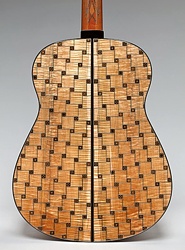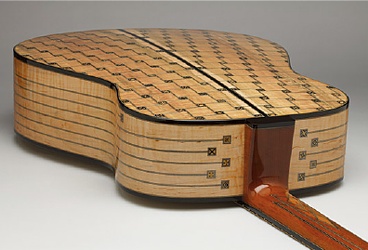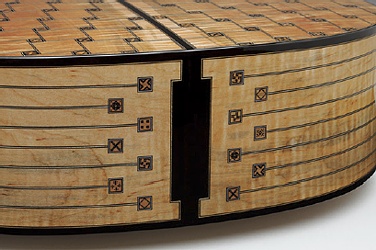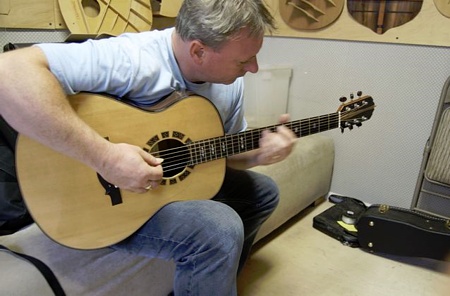Commentaries About My DVD
October 1, 2011
I have a DVD out; it’s a lecture I gave on the topic of Voicing the Guitar which I delivered at the Healdsburg Guitar Festival in 2009. It’s engendered both positive and negative comments. The negative ones generally have to do with the fact that I don’t reveal my specific methods for voicing the guitar — or at least not enough of them for anyone to usefully copy.
From the outset, that DVD was intended to have a dual purpose. First, I sought to give an overview of the principles of voicing the guitar — for which work I’m fairly well known — to people who are interested in the guitar but don’t yet know much about its actual ins and outs. Second, as the Healdsburg Guitar Festival happened shortly after the publication of my two-volume work The Responsive Guitar and Making The Responsive Guitar, the DVD was put out as a way of letting people know what these books are all about and how enormously informative they are. I mean, these books took me eight years to write: the one-hour lecture took a few days to plan out and prepare for.
My experience of lectures has been, on the whole, uninspiring. I’ve sat through a zillion boring ones in my life and I wanted to at least enliven mine with helpful signage, props, and visual aids. Otherwise I threw in every important thing about the workings of the guitar that I could think of short of the kitchen sink, and organized it into an hour-long presentation. These relevant concepts are:
- the guitar as an air pump
- monocoque engineering vs. structural engineering (i.e., the guitar as a monocoque)
- the monopole and the cross- and long dipoles as the principal vibrating modes of the guitar
- the Cube Rule of materials stiffness
- stiffness-to-weight-ratios
- the different tonal functions of steel string vs. classic guitars
- the usefulness of tap tones as a guide to structure
- the Acoustic Gradient of the top
- the different strategies for organizing modal movement represented by “X”, ladder, lattice, and fan bracing
- mechanical impedance
- the acoustic functions of the guitar back
- the guitar top and back as harmonic oscillators
- structural coupling / connectedness / disconnectedness in bracing and structure
- differential rates of energy use or discharge as a function of structure, and
- a realistic representation, via a constructed-to-scale bracing-stiffness diorama, of ACTUAL stiffnesses of various structural members and braces.
My lecture was not intended to be an exposition of specific techniques of carving braces — which is what most people think “voicing” is. The whole point of it was to let people know that the shaping of braces is part of a package that involves a whole lot more than that.
Such considerations have not stopped others from putting out instructional DVDs that focus on the kinds of mechanical shaping and assembly operations which can be carried out serially and without reference to how the various parts combine and interact. However, Voicing work is precisely about how the different components interact dynamically. Therefore, it requires actual Thinking, Consideration, Judgment, Experience, Tracking, and Presence of Mind. It’s a bit like playing chess. Yet many people think of Voicing more as working a slot machine — and hoping that there’s a secret technique for how to pull the handle correctly to win. I don’t think there is a secret technique; instead, a specific skill set is needed. I voice each one of my guitars personally, slowly and attentively in a process that stretches out over a day and a half or two every time, and involves all the factors I listed above. It’s not any kind of quick formulaic slam-dunk.
I stopped short of showing the audience my own specific methods of profiling braces, and I erred when, in responding to an audience member’s question, I said that people would have to take my class to find out what I actually do in shaping my guitar tops’ braces. I think I blew it on that one. If I had it to do over again I would not have said that glib and flip sounding sentence — and I unfortunately didn’t think to point out that my bracing is described and illustrated at length in my books (although, if I’d had, I might have come across as being even more of a shill for them). I would have explained instead that I did not wish to do so for two reasons. First, what I do is the end result of decades of learning, experimenting, and making some really bad sounding guitars. So it’s understandable that I’d feel proprietary about the specific ways in which I’ve achieved my results: I feel they are mine to share, but I don’t do that indiscriminately in public forums. Second, to simply show what my guitars’ innards look like, mechanically, and without explaining what thinking and design variables this work entails, is bad teaching.
So, instead, I spent the hour describing the factors and variables that inform my own voicing work. While I use these principles, I don’t feel that I own them. I more or less slowly and painstakingly discovered them where Nature had left them lying around in plain sight for anyone to find. If anything, I am indebted to them for helping me to do my work successfully: they have allowed me to arrive at better methods, thinking about, and approaches to lutherie. Mainly, they are more useful than any description of any specific mechanical technique can be — in spite of the fact that today’s emphasis in teaching is to focus on specific techniques rather than on understanding how something works. My attitude is based in the fact that the principles cost me years of work and time to learn. The specific techniques, on the other hand, are easy to learn and do: glue this, cut here, profile in this way, shave that down, taper it, tuck this into that, etc.
The factors of Voicing that I outlined in my lecture lend themselves to many ways of being used and implemented to achieve a wide variety of better results in guitar making — just as different specific ingredients can be combined in many ways to make a meal. I described these factors in non-scientific everyday language because I wanted to make them accessible and easily comprehensible. I tried to give the audience a good foundation, or starter kit, toward their being able to achieve better results — instead of spoon-feeding them rote methods. All in all, I did my best to give the audience the kind of starter kit that was nowhere available when I was starting out, and as far as I know it is still not available to luthiers from any source other than my writings. There are engineering and physics texts that cover this same material, but these are generally scientific exposition written by engineers and physicists for other engineers and physicists. Get a hold of Richard Mark French’s book “Engineering the Guitar: theory and practice”, and you’ll see what I mean. It’s a fine book, but not all that easy for the layman to read.
My presentation wasn’t intended to be a strip show where I reveal everything, nor a tease in which I hold information back. I was attempting to deliver pertinent information. It’s ironic that some people feel shortchanged by my not having given them specific information about WHAT MY CURRENT BRACING LOOKS LIKE — even though my lecture includes an explanation of what every known bracing pattern does or doesn’t do. I am of the opinion that if I’d shown the audience “my secret bracing patterns”, everybody would have immediately forgotten everything I’d said and gone home and started to copy what they’d seen me do as faithfully as they could — without putting any effort at all into understanding how the things I’d discussed participate in the making of sound. I think that’s really lousy teaching; it reduces complex relationships to lowest-common-denominator factoids.
The principal subtext of my lecture is that (1) most guitars made today are waaaay overbuilt, and (2) comparatively small amounts of wood added to or taken away from certain key points of the top-as-vibrating-diaphragm make huge differences. My “secret bracing patterns” don’t look all that much different from most other guitar bracing — and various ones I’ve used are shown in my books.
I say “various ones” because my building style has always evolved and continues to evolve. What I’d be showing this year is merely what I’m doing this year. It’s different than what I was doing five years ago and different from what I’ll be doing five years from now. Same principles, different applications. I am aware that the world has changed a lot during my professional lifetime and that people want information simplified and they want it quickly. But I really can’t provide genuinely useful information in recipe form and still feel I’ve done a good job. Trust me: I’m not getting rich off DVD sales.
I’ve heard complaints that my DVD was made mostly as an adjunct toward promoting my books. Well no, not mostly — although there is some truth in it. The fact is that the books are unquestionably more informative than any one-hour presentation can ever be. Nonetheless, in both efforts I’m concerned with getting people to think and make discoveries for themselves based on a reliable map that I’d provided.
On a different track, I might say the following to someone who had approached me with these concerns: I don’t know you personally but, if I may ask: did you really not find anything useful in the DVD? Did it seem to you that I talked for an hour and said nothing important? And, for that matter, do you expect to learn anything more pertinent about any skilled hands-on and ears-on activity from watching any DVD? I’d think that the stiffness-diorama example alone is an eye-opening GENERAL concept that applies to any guitar making effort. Such dioramas are structural features in every guitar that’s ever been made and which is the strings’ job to drive and make work (or work against, in many instances); and shaving and profiling braces is meaningless outside of this context.
Finally, EVERY guitar will have it’s own slightly different and specific diorama-configuration of wood, graining, thickness, bracing, areas of greater or lesser stiffness and looseness that are necessarily part of a mechanical and tonal gradient. This is another essential concept that’s mighty useful to have regardless of how big, small, thin, thick, floppy, stiff, tapered, braced, etc., a guitar top might be; in fact, without it, any effort at shaping braces is as hit-or-miss as pulling the lever of a slot machine and hoping for a good result .
 Some of you may know that I made a rosewood Andamento guitar about two years ago; it’s a wonder of design and craftsmanship if I do say so myself. The cutting, the inlaying, and the design itself took a long time to execute; and the work also included the design and making of eleven separate rosette logs. It’s the most fancily inlaid thing I’ve ever produced.
Some of you may know that I made a rosewood Andamento guitar about two years ago; it’s a wonder of design and craftsmanship if I do say so myself. The cutting, the inlaying, and the design itself took a long time to execute; and the work also included the design and making of eleven separate rosette logs. It’s the most fancily inlaid thing I’ve ever produced.

